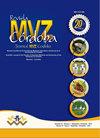Veterinary perspective of the renal system in sepsis
IF 0.3
4区 农林科学
Q4 AGRICULTURE, DAIRY & ANIMAL SCIENCE
引用次数: 0
Abstract
This paper aims to review, discuss and define the factors associated with development of kidney injury in patients with sepsis, diagnosis alternatives, therapy and prevention, offering to the veterinarians an updated guide to improve the prognosis of sepsis patients. Sepsis is a clinical condition that leads to systemic complications and to multiple organ dysfunction syndrome (MODS), mainly due to poor tissue perfusion in humans and animals. Acute kidney injury (AKI) is considered the most frequent and lethal among organ complications secondary to sepsis, however the etiology of AKI in patients with sepsis is complex and multifactorial and not completely elucidated. Early diagnosis of AKI is difficult and consequently the treatment is not very successful, due to hemodynamic aspects. The ultrasonography seems to be a promising exam for early diagnosis of this lesion, especially with the advent of contrast-enhanced ultrasonography (CEUS) technique, which makes possible to detect microcirculation changes in the renal parenchyma, opening the door for a variety of physiological, clinical and therapeutic applications, however, studies proving CEUS accuracy for early detection of renal damage related to sepsis in humans and animals are still necessary.脓毒症中肾脏系统的兽医观点
本文旨在综述、讨论和明确脓毒症患者肾损伤发生的相关因素、诊断选择、治疗和预防,为兽医改善脓毒症患者的预后提供最新的指导。脓毒症是一种导致全身并发症和多器官功能障碍综合征(MODS)的临床疾病,主要是由于人类和动物的组织灌注不良。急性肾损伤(AKI)被认为是脓毒症继发器官并发症中最常见和最致命的,然而脓毒症患者AKI的病因复杂且多因素,尚未完全阐明。由于血流动力学方面的原因,AKI的早期诊断是困难的,因此治疗不是很成功。超声检查似乎是早期诊断这种病变的一种很有希望的检查方法,特别是随着超声造影(CEUS)技术的出现,它可以检测肾实质的微循环变化,为各种生理、临床和治疗应用打开了大门,然而,证明CEUS在人类和动物败血症相关肾损害早期检测中的准确性仍然是必要的。
本文章由计算机程序翻译,如有差异,请以英文原文为准。
求助全文
约1分钟内获得全文
求助全文
来源期刊

Revista Mvz Cordoba
农林科学-奶制品与动物科学
CiteScore
0.70
自引率
0.00%
发文量
41
审稿时长
6-12 weeks
期刊介绍:
The Journal MVZ Córdoba is an open access international scientific journal financed and edited by the University of Córdoba (Colombia). The journal publishes quarterly, continuously in PDF, XML, Epub, original articles, literature reviews, brief communications and clinical cases, peer-reviewed (double-blind) in Spanish and English, which are related to the agricultural and veterinary sciences. The journal is directed to natural and legal persons of veterinary medicine, animal husbandry, public health, epidemiology, aquaculture, biology, basic biomedical sciences and biotechnology and constitutes a space for academic and scientific discussion around the work of professionals in Veterinary Medicine and Zootechnics. Four-monthly publication.
"The Journal MVZ Córdoba supports the policies for registration of clinical trials of the World Health Organization (WHO) and the International Committee of Medical Journal Editors (ICMJE), since it recognizes the importance of these initiatives for international registration and dissemination. of information about clinical studies, in open access. As a result, since 2007, the journal MVZ Córdoba only publishes clinical research articles that have received an identification number in one of the Clinical Trial Registries validated by the criteria established by WHO and ICMJE, whose addresses are available in the ICMJE website. The identification number is recorded at the end of the summary. "
 求助内容:
求助内容: 应助结果提醒方式:
应助结果提醒方式:


